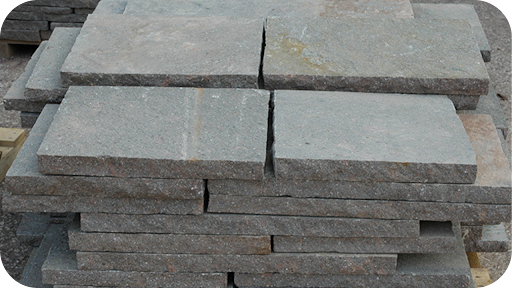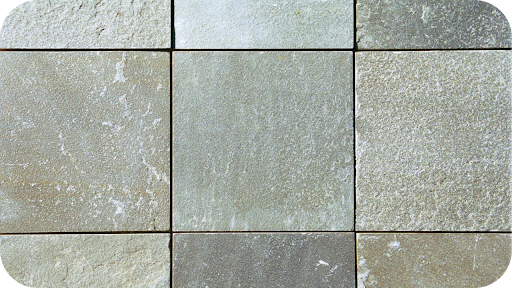
From modern builds to timeless homesteads, natural stone is a top choice for exterior wall cladding in Australia. Its unique blend of strength and style makes it ideal for boosting kerb appeal while standing up to the elements.
Whether you want a bold feature or a subtle finish, stone brings lasting beauty and performance to any façade. It also adds insulation and long-term value to your property.
In this guide, we’ll walk you through the best stones for cladding based on durability, looks, and practicality.
Top Stone Options for Exterior Wall Cladding
Looking for cladding that performs and impresses? These natural stones deliver on strength, visual impact, and longevity, with each variety offering something unique to match your style and environment.
1. Granite
Granite is ideal for demanding conditions, offering high strength and low maintenance. Varieties like Buffalo and Hotham showcase deep greys and blue undertones, perfect for sleek commercial facades or bold, modern residential designs.
2. Limestone
Limestone combines soft texture with earthy elegance. Varieties such as Marrakesh, Barwon, and Jasper feature warm greys and neutral creams, creating clean, understated exteriors that pair well with both timber and metal finishes.
3. Sandstone
Sandstone offers natural character through layered textures and warm colours. Options like Charlotte, Roman Ashlar, and Stirling bring rustic charm, especially suited to coastal homes, garden walls, or Federation-style architectural settings.
4. Quartz
Quartz is prized for its refined finish and durability. Varieties like Shoreham, Blanco, and Minas feature light greys, soft creams, and cool whites, adding polished depth to contemporary homes and minimalist building facades.
5. Travertine
Travertine brings timeless appeal with its signature pitting and soft tones. Silver and Classic travertine are ideal for Mediterranean-inspired homes, offering a relaxed, sun-washed look that suits low-exposure walls and decorative highlights.
Popular Finishes for External Cladding Stones
Stone finishes shape the final look and feel of a façade. Here’s how each option performs visually and functionally in exterior wall cladding applications.
- Split Face Finish: Offers a rough, textured surface with depth and dimension. It’s ideal for creating bold feature walls and plays beautifully with natural light and shadow outdoors.
- Honed Finish: Features a smooth, matte surface with no shine. Perfect for modern designs, this finish provides a clean, understated look that highlights the stone’s natural tones.
- Tumbled Finish: Creates a weathered, aged appearance with softened edges. Best for rustic or traditional homes, it brings a warm, relaxed feel to exterior walls.
- Polished Finish: Provides a high-gloss, reflective surface, typically used on marble and quartz. Ideal for low-exposure areas where elegance and luxury are a top priority.
- Natural Cleft Finish: Retains the raw, uneven surface formed during stone splitting. It’s a great choice for earthy, informal styles where authenticity is essential.
Why Choose Natural Stone for Exterior Cladding?
Natural stone is a trusted exterior cladding option thanks to its durability, timeless beauty, and performance. Here’s why it’s ideal for enhancing your building’s façade.
1. Delivers Long-Term Durability
Stone naturally withstands Australia’s tough weather conditions. It resists moisture, heat, and UV damage, ensuring your exterior remains strong and intact for decades without cracking, warping, or fading.
2. Offers Timeless Visual Appeal
Natural stone adds enduring charm that never goes out of style. Whether used on a contemporary build or a traditional home, its unique colours and textures offer an upscale, authentic finish.
3. Provides Excellent Thermal Insulation
Stone acts as a natural barrier to temperature changes. It helps keep interiors cooler in summer and warmer in winter, reducing energy use and increasing overall thermal comfort year-round.
4. Outperforms Manufactured Alternatives
Unlike manufactured cladding, stone won’t delaminate, fade, or degrade over time. It offers a genuine look with fewer maintenance concerns and a far longer lifespan, making it more cost-effective long term.
5. Requires Minimal Maintenance
Natural stone is incredibly low-maintenance. With no need for frequent painting or sealing (depending on type), it only requires occasional cleaning to maintain its look and structural integrity.
6. Boosts Property Value
Stone cladding adds a premium feel that enhances kerb appeal and resale value. Its timeless appearance and long-lasting quality make it a smart investment for any residential or commercial project.
How to Choose the Right Stone for Your Project
Stone cladding is more than just a design choice. It must suit your environment, budget, and aesthetic goals. Here’s what to consider before making your selection.
1. Assess Your Local Climate
Climate greatly affects stone performance. In coastal or wet areas, opt for dense, less porous stones like granite or quartz. For dry regions, limestone or travertine may perform just as well outdoors.
2. Match Your Architectural Style
The stone you select should align with your home’s design language. Clean quartz suits minimalist builds, while warm sandstone and aged limestone enhance rustic, coastal, or heritage-style homes beautifully.
3. Balance Beauty with Maintenance
Some stones require more upkeep. Travertine and sandstone may need sealing to prevent staining. Granite and quartz offer a more durable, low-maintenance solution while still delivering premium visual appeal long-term.
4. Factor in Your Budget
Natural stone pricing varies widely. Granite and marble sit at the premium end. Limestone and sandstone offer strong value, providing a beautiful look without stretching your project’s overall budget.
5. Consider Availability and Sourcing
Choosing a locally available stone, such as Shoreham quartz or Charlotte sandstone, can reduce wait times, minimise costs, and support Australian suppliers while ensuring consistency across larger cladding projects.
Installation Methods for Stone Wall Cladding
Proper installation is key to long-lasting cladding performance. The method you choose affects durability, cost, and appearance. Here are the most common techniques used for natural stone cladding.
1. Mechanical Fixing
This method uses metal anchors or brackets to attach stone panels securely to the wall. It’s ideal for heavy stones like granite or marble and offers excellent structural strength and long-term reliability.
2. Adhesive Systems
Adhesive systems involve bonding stone directly to the wall using construction-grade glue. They’re best for lighter stones and decorative applications, offering a quicker, cleaner installation on flat, load-bearing surfaces.
3. Ventilated Facade Systems
A ventilated system creates a cavity between the cladding and wall, improving airflow and reducing moisture buildup. This method enhances energy efficiency and is ideal for buildings in humid or coastal regions.
4. Jointed Installation
This method uses mortar to bond and fill the joints between stone pieces. It improves weather resistance, structural integrity, and visual cohesion, especially on exterior walls exposed to heavy rainfall or wind.
5. Cladding with Cavity System
This method involves fixing stone to a secondary support wall with an intentional air gap behind it. The cavity allows drainage and ventilation, reducing moisture buildup and improving long-term durability and thermal regulation.
Care and Maintenance Tips for Long-Lasting Stone Wall Cladding
Stone wall cladding is built to last, but proper care ensures it looks great for years. Here are essential maintenance practices to keep your exterior performing at its best.
- Use pH-Neutral Cleaners: Avoid acidic or harsh chemicals that may damage the surface or strip sealants. Stick to pH-neutral cleaners and soft brushes for routine washing.
- Seal Porous Stones: Stones like limestone, travertine, and sandstone benefit from sealing. It helps prevent staining, moisture absorption, and weather damage, especially in exposed or high-traffic areas.
- Check for Water Damage: Regularly inspect joints and mortar for cracks or gaps where water might seep through. Early repairs prevent long-term structural issues and staining.
- Clear Surface Debris: Remove leaves, dirt, and grime buildup, especially in textured finishes like split face or tumbled stone. This helps preserve both appearance and surface longevity.
- Avoid High-Pressure Washing: High-pressure jets can erode softer stones and loosen joints. Instead, use gentle, controlled rinsing methods to protect both finish and structure.
- Reapply Sealant as Needed: Depending on the stone and climate, resealing may be required every 2–5 years. Follow product guidelines to maintain maximum protection.
Conclusion
Natural stone wall cladding delivers unmatched durability, beauty, and long-term value for any exterior project.
By choosing the right stone, finish, and installation method, you’ll achieve a façade that performs as impressively as it looks. With minimal maintenance, it continues to add style and strength for decades.
For expert advice and a premium range of stone options, reach out to the team at Splendour in Stone today.
More To Explore

Choosing the Right Porphyry Cobblestones Supplier: What to Look For
Selecting the right cobblestones can define the quality and longevity of an outdoor project. The stone itself matters, but the supplier behind it often makes

Quartzite Pavers for Sale: Why They’re Worth the Investment
When planning an outdoor space, the choice of paving can make all the difference. It needs to be strong enough to handle daily use, stylish


